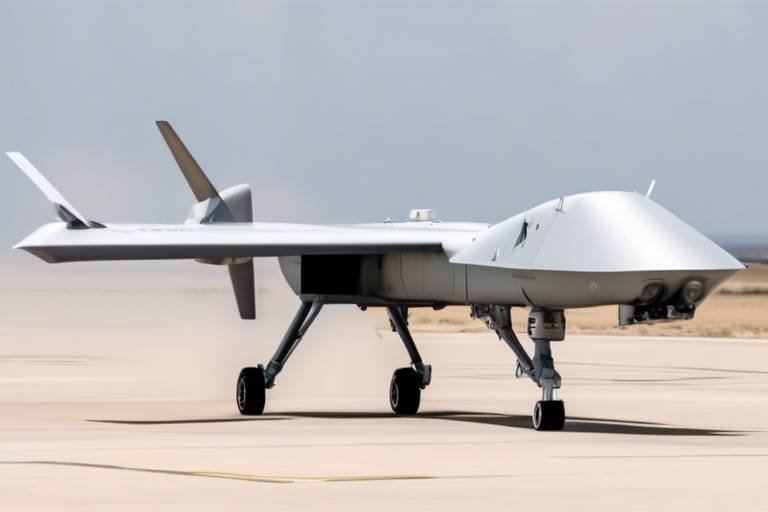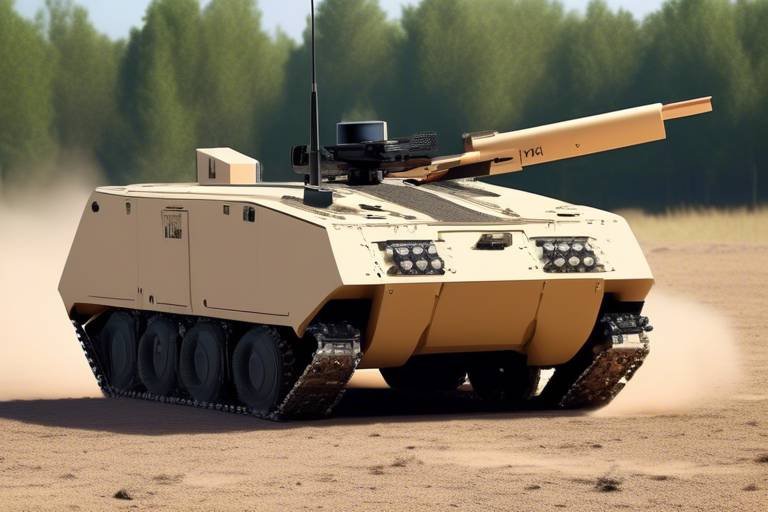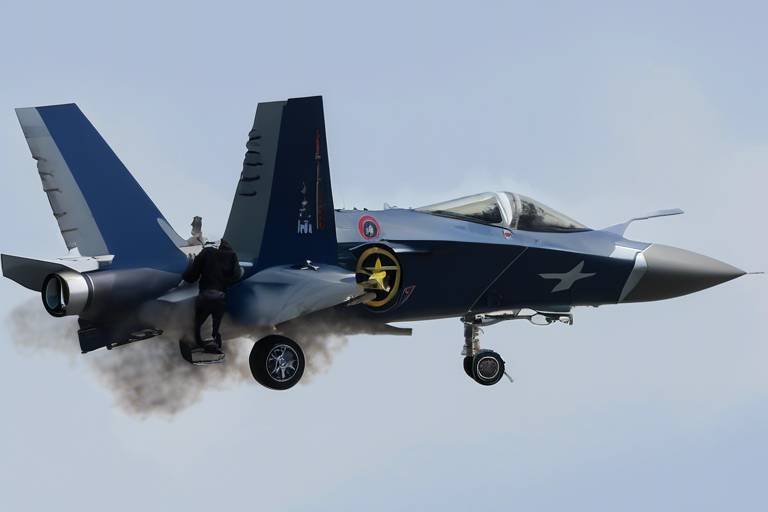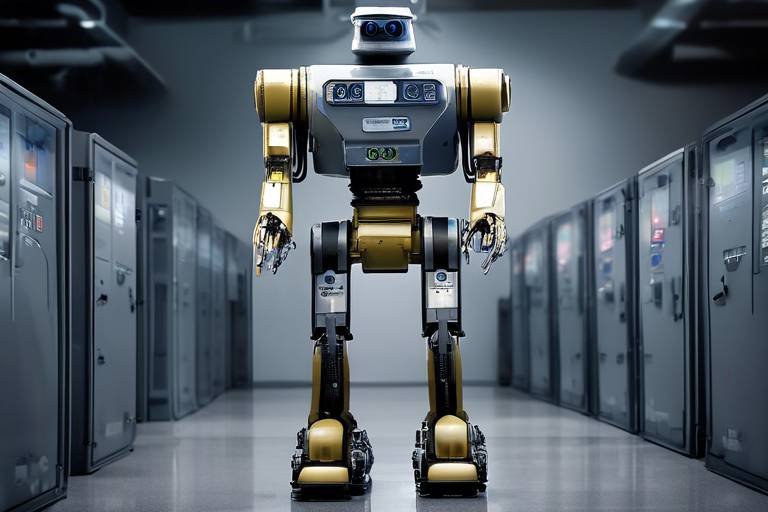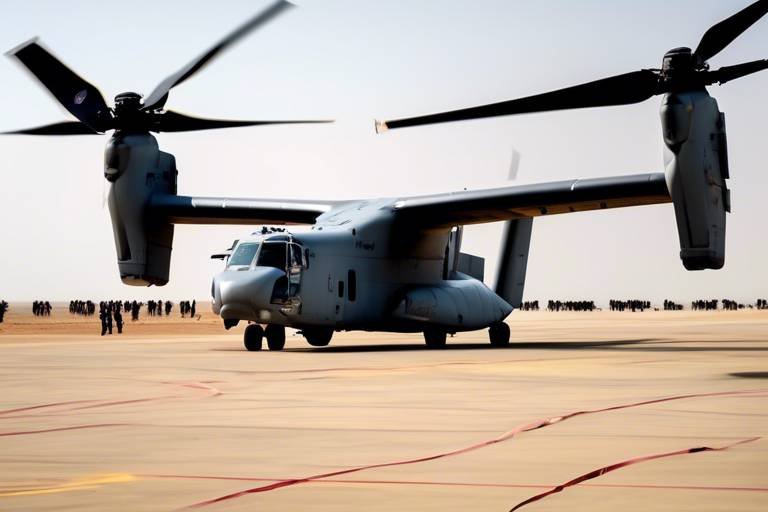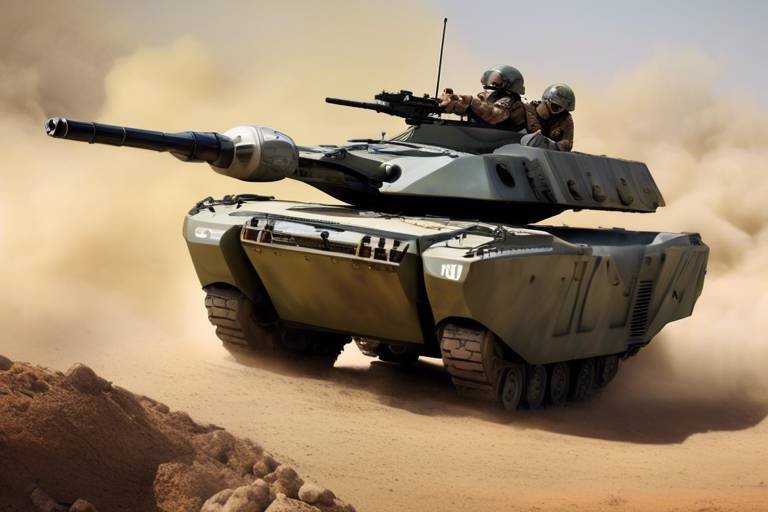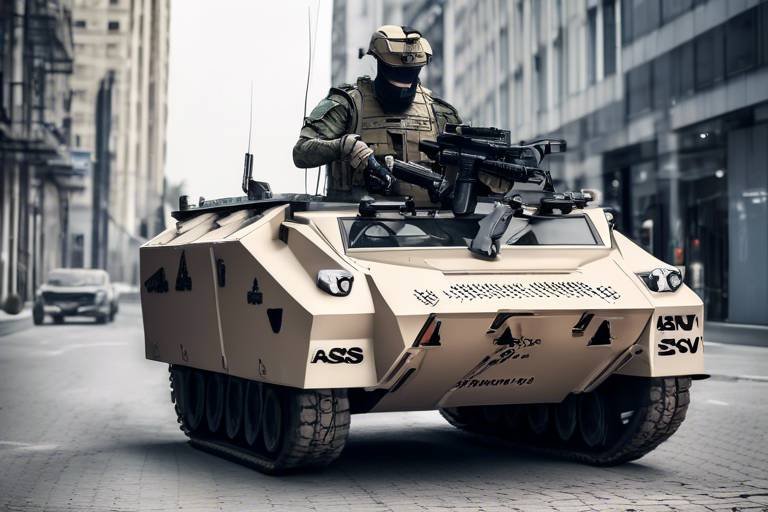Assessing the Capabilities of the Robotic Sentry in Base Defense
The world of military defense is rapidly evolving, and at the forefront of this transformation are robotic sentries. These advanced machines are not just a glimpse into the future; they are already redefining how military bases operate. Imagine a security system that never sleeps, tirelessly monitoring vast perimeters with the precision of a hawk. That's the promise of robotic sentries. In this article, we will explore their functionalities, advantages, and limitations, shedding light on their role in enhancing security and operational efficiency.
At the heart of robotic sentry technology lies a blend of artificial intelligence and machine learning. These systems are designed to autonomously monitor and protect military installations, utilizing a range of core components that enhance their functionality. For instance, robotic sentries are equipped with high-definition cameras, motion sensors, and advanced communication systems. This allows them to not only observe but also to process and respond to potential threats in real-time. The integration of these technologies means that a robotic sentry can analyze its surroundings, identify unusual activities, and alert human operatives, all while functioning around the clock.
The integration of robotic sentries into military base operations brings forth a plethora of advantages. One of the most significant benefits is their cost-effectiveness. While the initial investment might be substantial, the long-term savings in terms of reduced manpower and enhanced operational efficiency can be immense. Additionally, robotic sentries provide increased surveillance capabilities that far surpass traditional methods. With their ability to monitor vast areas without fatigue, they drastically reduce the risk of human error and oversight.
Robotic sentries are equipped with sophisticated sensors and cameras that allow for continuous monitoring of perimeters. This technology not only enhances situational awareness but also significantly improves response times in critical situations. For example, if a breach occurs, the robotic sentry can immediately relay information to human operatives, allowing them to react swiftly. The integration of AI means these machines can learn from past encounters, adapting their surveillance techniques to become even more effective over time.
The ability to analyze data in real time is crucial for effective defense. Robotic sentries process information quickly, identifying potential threats before they escalate. Imagine a scenario where an intruder approaches a military base; a robotic sentry can detect unusual movement patterns, assess the situation, and alert human personnel instantly. This rapid data processing not only enhances security but also provides a vital advantage in decision-making processes.
Advanced imaging technologies, such as night vision and thermal imaging, enable robotic sentries to operate effectively in low-light conditions. This capability is essential in base defense scenarios, where threats can emerge at any hour. The ability to see in darkness allows these sentries to maintain vigilance when human operatives may be less effective. By utilizing these technologies, robotic sentries ensure that military bases remain secure around the clock, regardless of environmental challenges.
Despite their numerous advantages, robotic sentries do face limitations. One major concern is their vulnerability to hacking. As technology advances, so do the methods employed by malicious actors. Ensuring that robotic sentries are secure from cyber threats is paramount for their effectiveness. Additionally, technological constraints can limit their operational capabilities in certain environments. For example, extreme weather conditions may hinder their performance, necessitating ongoing research and development to enhance their resilience.
The collaboration between robotic sentries and human personnel is essential for effective defense strategies. While robotic systems can monitor and analyze, human oversight remains critical for decision-making. The synergy between human intuition and robotic efficiency creates a robust defense mechanism. Training operatives to work alongside these machines is vital, as it ensures that personnel can leverage the strengths of robotic sentries while compensating for their limitations.
Training human operatives to work alongside robotic sentries is vital for seamless integration. This involves not only understanding how to operate the technology but also how to interpret the data it provides. Training methods may include simulations, hands-on experiences, and ongoing education to keep personnel updated on the latest advancements in robotic technology. Adaptability is key; as new features and capabilities are developed, operatives must be prepared to adjust their strategies accordingly.
As technology evolves, so too will the capabilities of robotic sentries. Future advancements could include enhanced AI algorithms that allow for even more sophisticated threat detection, improved mobility for navigating difficult terrains, and better energy efficiency to extend operational periods. The potential for these machines is vast, and as they continue to develop, they will undoubtedly play an increasingly pivotal role in base defense scenarios.
- What are robotic sentries? Robotic sentries are advanced machines equipped with AI and sensors, designed to monitor and protect military installations.
- How do robotic sentries enhance security? They provide continuous surveillance, real-time data analysis, and advanced imaging capabilities, improving situational awareness.
- What are the limitations of robotic sentries? Key limitations include vulnerability to hacking and potential performance issues in extreme weather conditions.
- How can human operatives effectively work with robotic sentries? Through proper training and understanding of the technology, human operatives can leverage the strengths of robotic sentries while making informed decisions.
- What does the future hold for robotic sentries? Future developments may include enhanced AI, improved mobility, and greater energy efficiency, further solidifying their role in military defense.

Overview of Robotic Sentry Technology
Robotic sentry technology represents a significant leap forward in the realm of military defense systems. These autonomous units are designed to enhance security measures around military installations, utilizing a combination of artificial intelligence (AI), machine learning, and advanced sensor technologies. At the heart of these robotic sentries lies a sophisticated architecture that enables them to operate independently while making critical decisions in real-time. Imagine a vigilant guardian that never sleeps—this is the essence of robotic sentry technology.
The core components of robotic sentries include a variety of sensors, cameras, and communication systems that work in tandem to provide comprehensive surveillance. For instance, many robotic sentries are outfitted with 360-degree cameras that can capture high-definition video footage, ensuring that no blind spots exist in their field of view. Additionally, these systems often employ infrared sensors and motion detectors to identify movement and potential threats even in the dead of night. This multi-layered approach to surveillance significantly enhances the security of military bases.
One of the most fascinating aspects of robotic sentry technology is its reliance on machine learning algorithms. These algorithms allow the sentries to learn from their environment and adapt to changing conditions. For example, if a robotic sentry detects a new type of vehicle or person entering its designated area, it can analyze the data and determine whether the entity poses a threat. Over time, with continuous learning, these systems become more adept at distinguishing between benign and hostile actions, thus improving their overall effectiveness.
Furthermore, robotic sentries are often equipped with communication systems that enable them to relay information back to human operators in real-time. This connectivity ensures that personnel are always informed about potential threats and can make quick, informed decisions. The integration of these technologies not only enhances the operational efficiency of military bases but also allows for a more proactive approach to security.
In summary, the overview of robotic sentry technology reveals a complex yet highly effective system designed to bolster military base defenses. By leveraging cutting-edge technologies, these sentries provide a level of surveillance and response that is unparalleled in traditional security measures. As we delve deeper into the benefits and limitations of these systems, it becomes clear that the future of military defense may very well hinge on the continued development of robotic sentries.
- What are robotic sentries?
Robotic sentries are autonomous units designed to monitor and protect military installations, utilizing AI and advanced sensors. - How do robotic sentries enhance security?
They provide continuous surveillance, analyze data in real-time, and can operate in various conditions, including low-light environments. - What are the limitations of robotic sentries?
They face challenges such as technological constraints, vulnerability to hacking, and the need for human oversight. - How do human operatives interact with robotic sentries?
Human personnel are crucial for decision-making and oversight, ensuring that robotic systems operate effectively within security protocols.

Benefits of Robotic Sentries
The integration of robotic sentries into military base defense is not just a trend; it's a game changer. Imagine having a vigilant guardian that never tires, never blinks, and is always on the lookout for potential threats. This is the reality that robotic sentries bring to the table. They offer a myriad of advantages that can significantly enhance the security and operational efficiency of military installations. Let's dive into some of the key benefits that make these technological marvels indispensable in modern defense strategies.
First and foremost, one of the most notable benefits is their cost-effectiveness. Implementing robotic sentries can lead to substantial savings in terms of personnel costs and resource allocation. With the ability to perform tasks that would typically require multiple human operatives, these robots can help streamline operations and reduce the need for extensive manpower. This is particularly crucial in an era where budgets are tight, and every dollar counts.
Moreover, robotic sentries provide increased surveillance capabilities. Equipped with an array of advanced sensors, cameras, and even drones, they can monitor vast areas with precision. This enhanced surveillance not only improves situational awareness but also allows for quicker response times to any potential threats. For instance, if an intruder is detected, the robotic sentry can immediately relay the information to human operatives, enabling them to act swiftly and decisively.
Imagine a scenario where a military base is under threat. The first line of defense is crucial. Robotic sentries, with their sophisticated technology, can continuously monitor perimeters and detect unusual activities. Their capabilities are enhanced by:
- High-resolution cameras that capture clear images, day or night.
- Advanced motion sensors that trigger alerts at the slightest disturbance.
- Network connectivity that allows for real-time data sharing with command centers.
This level of surveillance ensures that no stone is left unturned, providing peace of mind and a robust defense mechanism.
Another significant benefit is the ability of robotic sentries to conduct real-time data analysis. In the fast-paced world of military operations, timely information can be the difference between thwarting an attack and facing dire consequences. These sentries are designed to process vast amounts of data quickly, identifying potential threats before they escalate. They utilize machine learning algorithms to continuously improve their threat detection capabilities, ensuring that they stay one step ahead of potential adversaries.
Further enhancing their utility, robotic sentries are often equipped with night vision and thermal imaging technologies. This means that even in low-light conditions, they can maintain a high level of operational effectiveness. Think of them as the night watchmen who can see in the dark, providing an extra layer of security during vulnerable hours. In base defense scenarios, this capability is invaluable, allowing for 24/7 monitoring without the limitations faced by human personnel.
In conclusion, the benefits of robotic sentries in military base defense are multifaceted. From cost savings and enhanced surveillance to real-time data processing and advanced imaging technologies, these robotic systems are revolutionizing how we approach security. As we continue to explore their capabilities, it becomes increasingly clear that they are not just tools but vital components of a comprehensive defense strategy.
- What are robotic sentries?
Robotic sentries are automated systems equipped with sensors and cameras designed to monitor and protect military installations. - How do robotic sentries improve security?
They enhance surveillance capabilities, provide real-time data analysis, and operate effectively in various conditions, including low-light environments. - Are robotic sentries cost-effective?
Yes, they can significantly reduce personnel costs and streamline operations, offering savings to military budgets. - Can robotic sentries operate at night?
Absolutely! Many are equipped with night vision and thermal imaging technologies, allowing them to function effectively in darkness.

Enhanced Surveillance Capabilities
When it comes to military base defense, the eyes of the operation are often the most critical component. Robotic sentries are equipped with an array of advanced sensors and cameras that provide unparalleled surveillance capabilities. Imagine having a vigilant guard that never tires, never blinks, and can see in ways that the human eye simply cannot. These robotic sentries are designed to monitor perimeters continuously, ensuring that any unusual activity is detected and addressed promptly.
One of the standout features of these robotic sentries is their ability to integrate multiple types of surveillance technologies. For instance, they can utilize high-definition cameras for clear daytime visibility, while also incorporating infrared sensors to detect heat signatures during the night. This combination allows them to maintain a watchful eye around the clock, regardless of lighting conditions. In fact, many of these systems can switch seamlessly between various modes, adapting to environmental changes in real-time.
Moreover, the data collected by these sensors is not just stored for later use; it is analyzed on the spot. This means that as soon as a potential threat is detected, the robotic sentry can assess the situation and alert human operatives if necessary. The integration of artificial intelligence and machine learning algorithms enables these sentries to differentiate between normal activities and potential threats. For example, they can recognize the difference between a harmless animal wandering into the vicinity and a person behaving suspiciously.
To illustrate the effectiveness of robotic sentries in enhancing surveillance, consider the following table that compares traditional surveillance methods with robotic sentry capabilities:
| Feature | Traditional Surveillance | Robotic Sentry Surveillance |
|---|---|---|
| Operational Hours | Limited (human fatigue) | 24/7 |
| Response Time | Variable (depends on human attention) | Instantaneous (real-time alerts) |
| Environmental Adaptability | Limited (daylight only) | High (night vision, thermal imaging) |
| Data Analysis | Post-incident review | Real-time analysis |
This level of surveillance capability significantly enhances situational awareness for military personnel. With robotic sentries acting as the first line of defense, human operatives can focus their efforts on responding to verified threats rather than monitoring for potential issues. This shift allows for a more efficient allocation of resources and personnel, ultimately leading to a more secure environment.
In summary, the enhanced surveillance capabilities of robotic sentries represent a transformative leap in military base defense. By leveraging cutting-edge technology, these sentries not only provide continuous monitoring but also facilitate rapid response to potential threats, ensuring that military installations remain secure and operational efficiency is maximized.
- What types of sensors do robotic sentries use? Robotic sentries commonly use high-definition cameras, infrared sensors, and thermal imaging technology to monitor their surroundings effectively.
- Can robotic sentries operate in extreme weather conditions? Yes, many robotic sentries are designed to function in various weather conditions, including rain, snow, and extreme temperatures.
- How do robotic sentries communicate with human operatives? Robotic sentries typically use secure communication channels to send alerts and data to human operatives in real-time.
- Are robotic sentries vulnerable to hacking? Like any technology, robotic sentries can be susceptible to cyber threats, which is why robust security measures are essential for their operation.

Real-Time Data Analysis
In the realm of military base defense, the ability to analyze data in real time is nothing short of revolutionary. Imagine a world where threats are not just detected but anticipated, where the response to an incursion is swift and calculated. Robotic sentries are equipped with powerful algorithms and advanced processing capabilities that allow them to sift through vast amounts of data almost instantaneously. This capability transforms the landscape of security, turning reactive measures into proactive strategies.
At the heart of real-time data analysis in robotic sentries lies a combination of machine learning and artificial intelligence. These technologies enable the sentries to recognize patterns and anomalies in their environment. For instance, if a sentry detects an unusual movement at an unexpected hour, it can immediately analyze past behaviors, compare them against its database, and assess whether this movement poses a potential threat. This rapid assessment is crucial in military contexts where every second counts.
Moreover, the integration of sensor data plays a significant role in enhancing the situational awareness of these robotic systems. Sensors collect data on various parameters, including temperature, motion, and sound. When combined with AI algorithms, this data provides a comprehensive picture of the environment. For example, if a robotic sentry detects a sudden spike in temperature in a restricted area, it can cross-reference this data with other inputs to determine if it correlates with unauthorized activity, such as a fire or an intruder.
To illustrate the impact of real-time data analysis, consider the following table that outlines the key components involved:
| Component | Function |
|---|---|
| Data Sensors | Collect real-time data on environmental conditions. |
| AI Algorithms | Analyze data to identify patterns and anomalies. |
| Communication Systems | Transmit alerts and findings to human operatives. |
| Decision-Making Software | Facilitate rapid response actions based on data analysis. |
This seamless flow of information not only enhances the decision-making process but also significantly reduces the likelihood of human error. In high-stress situations, where the pressure to act quickly can lead to mistakes, robotic sentries provide a level of precision that is hard to match. They can analyze multiple data streams simultaneously, ensuring that no critical detail is overlooked.
Furthermore, the real-time capabilities of these systems mean that they can continuously learn and adapt. Every encounter, every anomaly is a learning opportunity. The more data a robotic sentry processes, the better it becomes at identifying potential threats. This self-improving aspect is akin to having a seasoned operative who learns from each mission, refining their skills and intuition over time.
In conclusion, the integration of real-time data analysis in robotic sentries is a game-changer for military base defense. It empowers these systems to not only detect threats but also to understand and respond to them with remarkable efficiency. As technology continues to evolve, we can only expect these capabilities to become even more sophisticated, ultimately enhancing the safety and security of military installations worldwide.
- What is real-time data analysis? Real-time data analysis refers to the capability of processing and interpreting data as it is collected, allowing for immediate insights and actions.
- How do robotic sentries utilize AI? Robotic sentries use AI algorithms to analyze data, recognize patterns, and make informed decisions quickly, enhancing their threat detection capabilities.
- Can robotic sentries operate in low-light conditions? Yes, many robotic sentries are equipped with night vision and thermal imaging technologies, allowing them to monitor environments effectively even in darkness.

Night Vision and Thermal Imaging
When it comes to base defense, the ability to see in the dark is not just a luxury; it's a necessity. Robotic sentries equipped with night vision and thermal imaging technologies provide a significant edge in surveillance operations, especially during nighttime or low-visibility conditions. Imagine a soldier trying to navigate a dark terrain—without the right tools, they might as well be walking blind. This is where these advanced imaging systems come into play, transforming the landscape of military security.
Night vision technology works by amplifying available light, allowing robotic sentries to detect and identify objects in darkness. On the other hand, thermal imaging detects heat emitted by objects, enabling these sentries to "see" in complete darkness, fog, or even smoke. This dual capability ensures that no potential threat goes unnoticed, making it a game-changer in base defense scenarios.
To illustrate the effectiveness of these technologies, consider the following table that compares traditional surveillance methods with robotic sentries equipped with night vision and thermal imaging:
| Feature | Traditional Surveillance | Robotic Sentries with Night Vision & Thermal Imaging |
|---|---|---|
| Visibility in Darkness | Poor | Excellent |
| Detection of Heat Signatures | None | Yes |
| Operational Range | Limited | Extended |
| Response Time | Slower | Faster |
As you can see, the advantages of robotic sentries are striking. With their ability to operate effectively in low-light conditions, they significantly enhance the overall situational awareness of military installations. This is particularly crucial in scenarios where intruders may attempt to exploit darkness to their advantage. The integration of these technologies into base defense not only improves detection rates but also accelerates response times, allowing for quicker action against potential threats.
Furthermore, the combination of night vision and thermal imaging creates a comprehensive surveillance system. For instance, while night vision might allow a sentry to see an individual lurking in the shadows, thermal imaging can reveal their exact position based on body heat. This dual-layer of analysis ensures a robust defensive posture, as operators can make informed decisions based on accurate, real-time data.
In conclusion, the incorporation of night vision and thermal imaging into robotic sentries represents a significant leap forward in military technology. These tools not only enhance visibility in challenging conditions but also empower defense personnel to act swiftly and decisively. As threats evolve, so too must our methods of detection and response, and robotic sentries are paving the way for a future where security is not just reactive but proactive.
- What is the primary function of night vision technology? Night vision technology amplifies existing light to enable visibility in dark conditions.
- How does thermal imaging work? Thermal imaging detects heat emitted by objects, allowing for visibility in complete darkness.
- Can robotic sentries operate effectively in all weather conditions? Yes, robotic sentries equipped with these technologies can function well in various weather conditions, including fog and rain.
- What are the advantages of using robotic sentries over traditional surveillance methods? Robotic sentries offer enhanced visibility, faster response times, and the ability to detect heat signatures, making them more effective in security operations.

Limitations and Challenges
While robotic sentries bring a plethora of advantages to military base defense, they are not without their limitations and challenges. One of the most pressing issues is the reliance on technology, which can be a double-edged sword. For instance, robotic sentries depend heavily on their software and hardware systems to function effectively. If these systems fail due to technical glitches or malfunctions, the entire defense mechanism could be compromised. Imagine relying on a high-tech guard that suddenly goes offline—it's a scenario that could lead to disastrous consequences.
Another significant challenge is the threat of hacking. As with any technology connected to a network, robotic sentries are susceptible to cyberattacks. Hackers could potentially gain control of these systems, turning them from protectors into threats. This vulnerability raises critical questions about the security of military installations. How can we ensure that our defenses are not just effective but also secure from external threats? The answer lies in robust cybersecurity measures that must be implemented alongside the deployment of robotic sentries.
Moreover, there are concerns regarding the ethical implications of using robotic sentries in military operations. The question arises: can machines make moral decisions? In high-stakes scenarios where split-second decisions are required, human judgment is irreplaceable. Robotic sentries lack the emotional intelligence and ethical reasoning that human operatives possess. This limitation necessitates a careful balance between automation and human oversight to ensure that the right decisions are made in the heat of the moment.
Additionally, the cost of implementation can be a barrier for many military organizations. While robotic sentries may save costs in the long run by reducing the need for human personnel, the initial investment in technology, training, and maintenance can be substantial. Budget constraints often force military leaders to weigh the benefits against the costs, which can lead to delays in adopting these advanced systems.
Finally, there is the challenge of public perception. The introduction of robotic sentries may raise concerns among the civilian population regarding privacy and the potential for misuse. How do we ensure that these systems are used responsibly? Transparency and clear communication about the role and limitations of robotic sentries are essential to foster public trust.
In summary, while robotic sentries offer enhanced capabilities for base defense, addressing their limitations and challenges is crucial for successful integration. From technological vulnerabilities to ethical dilemmas, these issues must be navigated carefully to ensure that military operations remain both effective and responsible.
- What are the primary limitations of robotic sentries?
Robotic sentries face challenges such as technological failures, vulnerability to hacking, ethical concerns, high implementation costs, and public perception issues. - How can hacking be prevented in robotic sentries?
Implementing robust cybersecurity measures, regular software updates, and monitoring systems can help mitigate hacking risks. - Are robotic sentries capable of making ethical decisions?
Currently, robotic sentries lack the emotional intelligence and ethical reasoning that human operatives possess, necessitating human oversight. - What are the costs associated with deploying robotic sentries?
The initial investment can be high, covering technology, training, and maintenance, but they may save costs in the long run by reducing the need for human personnel. - How can public perception of robotic sentries be improved?
Transparency and clear communication about their role and limitations can help foster trust among the civilian population.

Integration with Human Operatives
The collaboration between robotic sentries and human personnel is not just beneficial; it’s essential for developing effective defense strategies. Imagine a world where cutting-edge technology and human intuition work hand in hand. That's exactly what the integration of robotic sentries into military base defense aims to achieve. While robotic sentries are designed to enhance surveillance and response times, they cannot replace the critical thinking and decision-making skills of human operatives. This partnership creates a more robust defense mechanism, ensuring that bases are not only monitored but also managed effectively.
One of the most significant aspects of this integration is the need for human oversight. Robotic sentries can analyze data and detect potential threats, but they still rely on human operatives to make the final call. This is where the synergy becomes apparent. For instance, a robotic sentry may identify an unusual movement within its surveillance range. While it can alert human personnel, it is ultimately up to the human operator to assess the situation, analyze the context, and determine the appropriate response. This interplay of technology and human judgment enhances the overall security of military installations.
Moreover, the training of human operatives is paramount for the seamless integration of robotic sentries. Training programs must be designed to ensure that personnel are not only familiar with the technology but also adept at interpreting the data provided by these robotic systems. The training often includes simulations and real-life scenarios that teach operatives how to react in various situations. For example, operatives may undergo exercises where they practice responding to alerts generated by robotic sentries, allowing them to develop a quick and effective response strategy.
Additionally, adaptability plays a crucial role in this integration. As technology evolves, so too must the skills of the human operatives. Continuous training and updates are necessary to ensure that personnel can effectively utilize the latest advancements in robotic technology. This could involve learning new software, understanding upgraded sensors, or becoming familiar with enhanced data analytics capabilities. The more adaptable and knowledgeable the human operatives are, the more effective the integration with robotic sentries will be.
In summary, the integration of robotic sentries with human operatives is a dynamic relationship that enhances base defense strategies. It combines the speed and precision of robotic systems with the critical thinking and experience of human personnel. Together, they create a formidable defense mechanism that can respond to threats more effectively than either could alone. As we look to the future, this partnership will only grow more vital, with advancements in both robotics and human training paving the way for a safer and more secure military environment.
- What are robotic sentries? Robotic sentries are automated systems designed to monitor and protect military installations using advanced technology, including AI and machine learning.
- How do human operatives interact with robotic sentries? Human operatives oversee and make decisions based on the data and alerts provided by robotic sentries, ensuring effective response to potential threats.
- What training is required for personnel working with robotic sentries? Personnel require training that includes understanding robotic systems, data interpretation, and practical exercises to develop quick response strategies.
- What challenges exist in integrating robotic sentries with human operatives? Challenges include ensuring operatives are adequately trained, maintaining adaptability to technological advancements, and addressing potential vulnerabilities in robotic systems.

Training and Adaptability
In the rapidly evolving landscape of military defense, the integration of robotic sentries with human operatives is not just beneficial; it’s essential. To maximize the effectiveness of these advanced systems, proper training and adaptability are crucial. Human personnel must be equipped with the skills and knowledge to operate alongside robotic sentries, ensuring that the synergy between man and machine enhances overall security.
Training programs need to encompass a variety of aspects, from understanding the technological intricacies of robotic sentries to developing the tactical acumen necessary for real-time decision-making. This is not merely about learning how to control a machine; it's about fostering a mindset that embraces technology as a partner in defense operations. For instance, personnel must be trained to interpret data collected by robotic sentries, making them capable of responding to threats swiftly and effectively.
Adaptability is another key factor. The battlefield is unpredictable, and the ability to adjust tactics in response to changing conditions is vital. Robotic sentries can gather vast amounts of information, but human operators need to be prepared to interpret and act upon this data dynamically. This requires ongoing training and simulations that challenge operatives to think critically and adapt their strategies in real-time.
Moreover, as robotic technology continues to advance, training programs must evolve as well. This means staying updated with the latest developments in AI, machine learning, and robotics to ensure that personnel are not only familiar with current systems but are also prepared for future innovations. The following table outlines the essential components of a robust training program for operatives working with robotic sentries:
| Training Component | Description |
|---|---|
| Technical Training | Understanding the operational mechanics and software of robotic sentries. |
| Tactical Training | Developing strategies to effectively utilize robotic sentries in various scenarios. |
| Data Interpretation | Learning how to analyze and respond to data collected by robotic systems. |
| Simulations | Engaging in realistic scenarios to practice adaptability and decision-making. |
| Continuous Learning | Staying updated with the latest technological advancements and methodologies. |
In conclusion, the successful deployment of robotic sentries in military base defense hinges on the effective training and adaptability of human operatives. This partnership not only enhances operational efficiency but also strengthens the overall security framework. As we look to the future, the ability to train and adapt will define the success of integrating robotic technology into defense strategies.
- What skills are necessary for operatives working with robotic sentries?
Operatives should have technical knowledge of robotic systems, tactical planning skills, and the ability to analyze data quickly. - How does training impact the effectiveness of robotic sentries?
Proper training ensures that human operatives can effectively utilize robotic sentries, improving response times and decision-making in critical situations. - Are robotic sentries capable of learning from their experiences?
Yes, many robotic sentries utilize AI and machine learning, allowing them to adapt and improve their performance over time. - What challenges do operatives face when integrating robotic sentries?
Challenges include understanding complex technology, adapting to new systems, and ensuring seamless communication between human and robotic elements.

Future Developments in Robotics
This article explores the functionalities, advantages, and limitations of robotic sentries in military base defense, highlighting their role in enhancing security and operational efficiency.
Robotic sentries utilize advanced technology, including AI and machine learning, to monitor and protect military installations. This section will delve into the core components and systems that enable their functionality.
The integration of robotic sentries offers numerous advantages, such as cost-effectiveness, increased surveillance capabilities, and reduced human risk. This section outlines the key benefits they bring to base defense operations.
Robotic sentries are equipped with sophisticated sensors and cameras, allowing for continuous monitoring of perimeters. This subsection discusses how these technologies improve situational awareness and response times.
The ability to analyze data in real time is crucial for effective defense. This part examines how robotic sentries process information quickly to identify potential threats.
Advanced imaging technologies enable robotic sentries to operate effectively in low-light conditions. This segment explores the importance of night vision and thermal imaging in base defense scenarios.
Despite their advantages, robotic sentries face limitations, including technological constraints and vulnerability to hacking. This section highlights the challenges that must be addressed for optimal performance.
The collaboration between robotic sentries and human personnel is essential for effective defense strategies. This section discusses the importance of human oversight and decision-making in conjunction with robotic systems.
Training human operatives to work alongside robotic sentries is vital for seamless integration. This subsection examines the training methods and adaptability required for personnel to effectively utilize these technologies.
As technology continues to advance at a breathtaking pace, the future of robotic sentries in military base defense looks promising. One of the most exciting prospects is the integration of more sophisticated AI algorithms that can enhance decision-making processes. Imagine a robotic sentry that not only detects threats but also assesses their level of danger and suggests appropriate responses in real-time. This capability could revolutionize how military bases respond to potential intrusions.
Furthermore, advancements in robotic mobility are expected to allow sentries to navigate complex terrains more effectively. Future models may incorporate autonomous drones that can work in tandem with ground-based sentries, creating a multi-layered defense system. This would not only increase surveillance coverage but also provide a dynamic response to threats from various angles.
Another area of development is the enhancement of cybersecurity measures. As these robotic systems become more integrated into military operations, the potential for cyber threats increases. Future robotic sentries will likely employ advanced encryption and self-learning algorithms that can adapt to new hacking techniques, ensuring that they remain secure and operational in hostile environments.
Moreover, the use of biometric recognition technologies is on the rise. Imagine a robotic sentry that can distinguish between authorized personnel and potential threats based on facial recognition or other biometric markers. This capability would significantly reduce the chances of false alarms and enhance overall security.
In conclusion, the future of robotic sentries in base defense is bright and full of potential. As we continue to innovate and push the boundaries of technology, these sentries will evolve into even more capable defenders, ensuring that military installations are safer and more secure than ever before. The combination of AI, improved mobility, robust cybersecurity, and biometric technologies will set the stage for a new era in military defense.
- What are robotic sentries? Robotic sentries are automated systems designed to monitor and protect military installations using advanced technologies like AI and sensors.
- How do robotic sentries enhance security? They provide continuous surveillance, real-time data analysis, and can operate in various conditions, including low-light environments.
- What are the limitations of robotic sentries? They face challenges such as technological constraints, vulnerability to hacking, and the need for human oversight.
- What future developments can we expect? Future advancements may include improved AI algorithms, better mobility, enhanced cybersecurity, and biometric recognition capabilities.
Frequently Asked Questions
- What are robotic sentries and how do they work?
Robotic sentries are advanced security systems that utilize artificial intelligence and machine learning to monitor military installations. They are equipped with sensors and cameras that allow them to continuously observe their surroundings, analyze data in real time, and respond to potential threats effectively.
- What are the key benefits of using robotic sentries in base defense?
Robotic sentries offer numerous advantages, including enhanced surveillance capabilities, reduced human risk, and cost-effectiveness. They can operate around the clock, providing constant monitoring of perimeters, which significantly improves situational awareness and response times during potential security breaches.
- Can robotic sentries operate in low-light conditions?
Absolutely! Many robotic sentries are equipped with night vision and thermal imaging technologies, enabling them to function effectively even in complete darkness. This capability is crucial for maintaining security during nighttime operations when human visibility is limited.
- What limitations do robotic sentries face?
While robotic sentries are highly advanced, they do have limitations. These include technological constraints, potential vulnerabilities to hacking, and the need for human oversight. Addressing these challenges is essential to ensure optimal performance and security.
- How do human operatives integrate with robotic sentries?
Human operatives play a critical role in the effective deployment of robotic sentries. Training is essential for personnel to work alongside these systems, ensuring they can make informed decisions based on the data provided by the robotic units. This collaboration enhances overall defense strategies.
- What future developments can we expect in robotic sentry technology?
The field of robotics is constantly evolving, and future advancements may include improved AI algorithms, enhanced sensor technologies, and greater autonomy. These developments will likely enhance the effectiveness of robotic sentries in base defense scenarios, making them even more reliable and efficient.






